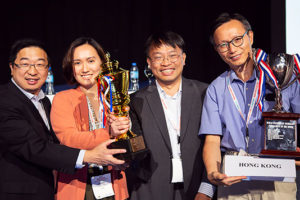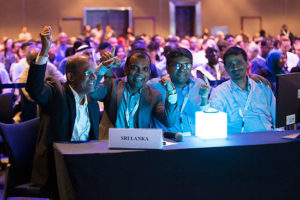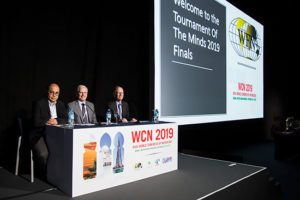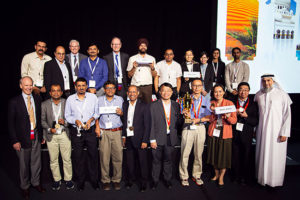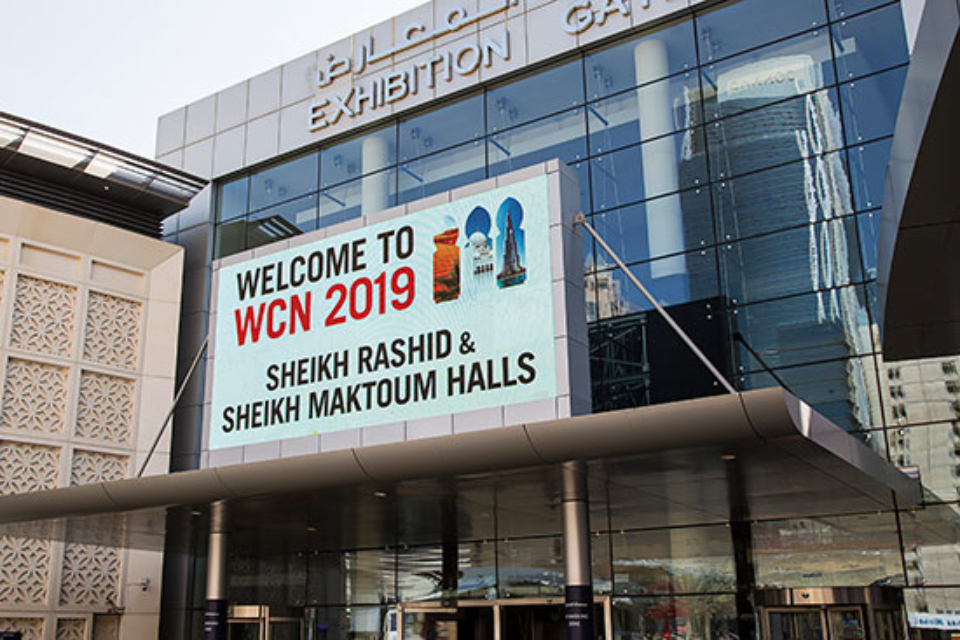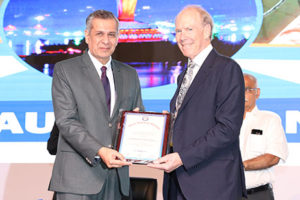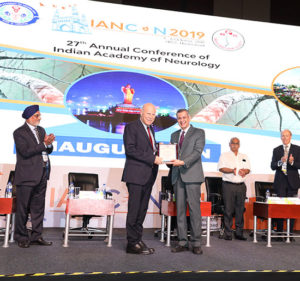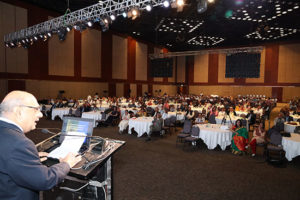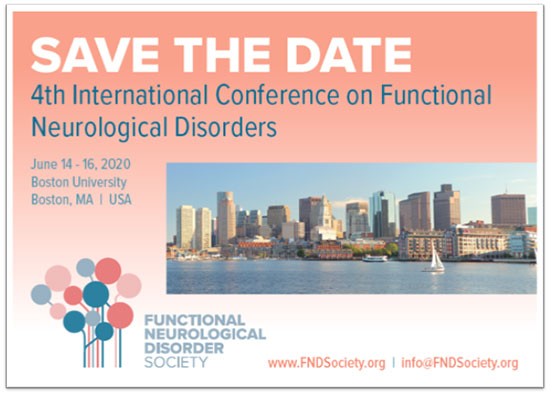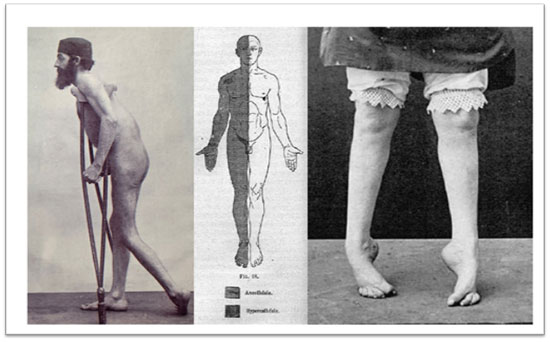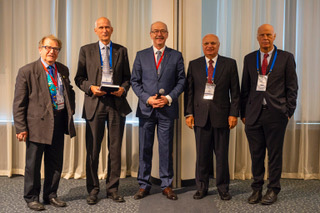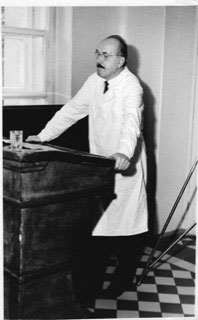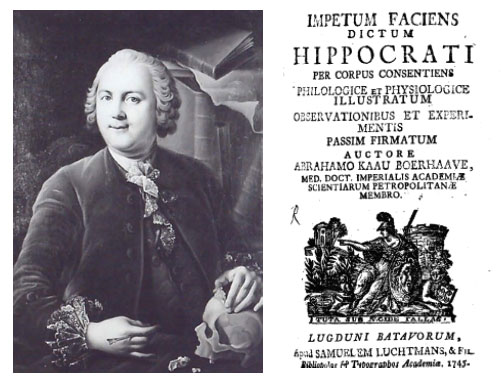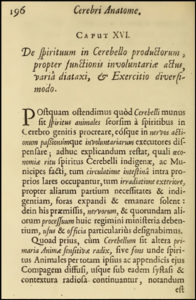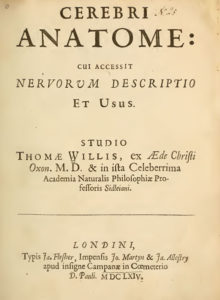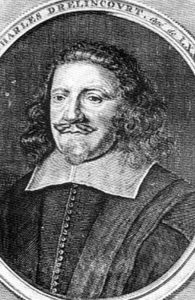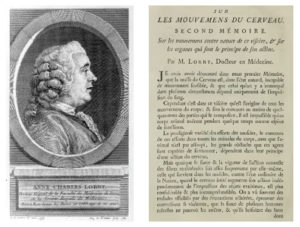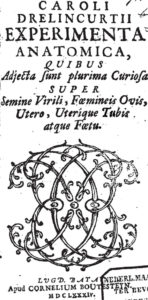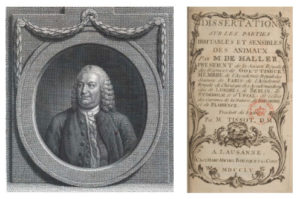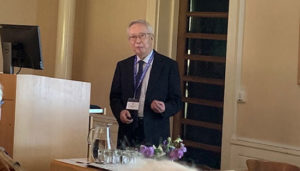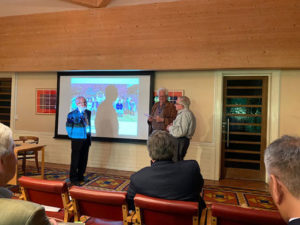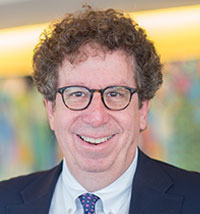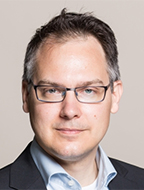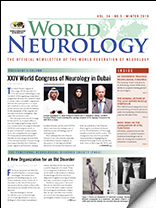By William Carroll
The Dubai World Congress of Neurology (WCN) was held Oct. 27-31 and was an outstanding success. On behalf of the organizing committees, I congratulate all those who worked so hard to ensure it was a successful congress and all those who participated in it to share and contribute to the success. I will first list the statistics that provide the skeleton for this assessment of the congress and then deal with those “intangibles” that make this conclusion certain.
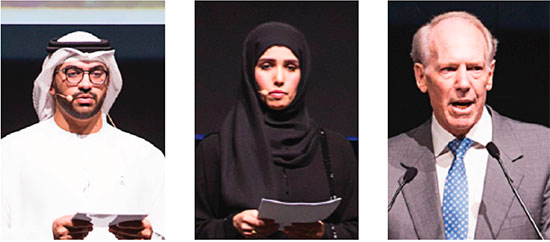
Emerati neurologists Dr. Reem Ahmed Al Suwaidi and Dr. Hamdan Al Zarouni, and WFN President William Carroll providing their opening comments at the Opening Ceremony to the XXIV WCN in Dubai.
The Opening Ceremony set the stage for the need for an increased effort to meet the burgeoning/looming crisis of non-communicable neurological disorders (NCNDs) confronting the world. In an aptly orchestrated commencement scene, two young Emirati neurologists (Dr. Reem Ahmed Al Suwaidi and Dr. Hamdan Al Zarouni) gave the bald facts of the estimated number of people facing neurological disability from dementia, stroke, migraine and headache, epilepsy, multiple sclerosis, and the other NCNDs, which make them the leading cause of disability and second leading cause of death globally.
Short addresses from the Director General of the Dubai Health Authority, His Excellency Humaid Alqatami, in the presence of His Highness Sheikh Ahmed bin Mohammed Al Maktoum, and from the presidents of the Emirates Neurology Society (Suhail Al Akrun) and the World Federation of Neurology (myself) echoed the need for action. The closing item was a short but powerful visual presentation highlighting the Emirates Neurology Society and the Pan Arab Union of Neurology, the WCN, and the current role of the World Federation of Neurology (WFN).
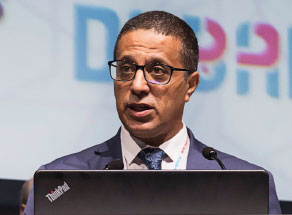
Dr Riadh Gouider read the citation for Dr. El Aloui Faris.
A total of 4,000 participants attended from a record number of 129 participating countries, 800 of whom were from the Middle East and North Africa. As expected, the majority of the 800, numbering some 580, were from the United Arab Emirates (UAE), Saudi Arabia, and Egypt. Despite the volatility in the region, countries such as Iran, Iraq, Lebanon, Syria, Kuwait, and Jordan had between 15 and 70 delegates each, a testament to their determination to attend and the generally helpful assistance in visa procurement from the Dubai Department of Tourism.
Overall, India had the largest number of attendees at about 400 followed by the UAE, Indonesia, the U.S., Saudi Arabia, the Philippines, China, South Korea, Egypt, and Japan with 100 making up the top 10 countries by numerical attendance.
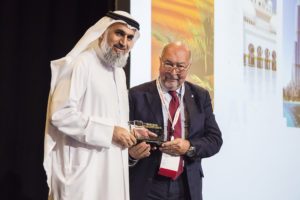
Prof. Suhail Al Akrun, president of the XXIV WCN, handing over the XXV WCN in Rome to Prof. Antonio Federico of the Italian Society of Neurology.
Of the total attendees who specified their professional role, 80% were clinicians or clinician researchers. Ten percent were students or basic science researchers. Of the 64% who specified an age bracket, the age range was spread fairly evenly between those younger than 35 years old, the 35-44 year olds, the 45-54 year olds and the 55-64 year olds. Those aged younger than 45 years comprised 44% while those older than 45 years made up 56%. Altogether, these broad demographic details fit the WFN target population, although a higher percentage of younger attendees would have been more satisfying.
Nevertheless, a record number of bursaries and travel grants, 200 in all, were offered to and accepted by young neurologists from low and low-middle income countries.
Like meetings of any size, the program content and quality of the presenters is paramount to success. From the first plenary session, it was evident this was going to be the case with this World Congress. Prof. Patrik Brunden’s lecture on “The Battle to Beat Parkinson’s Disease” was outstanding for its clarity and message and will mark a new perspective on the future understanding and hope for disease course modification. Prof. Russell Foster’s lecture “Light, Circadian Rhythms, and Sleep: Mechanisms to New Therapeutics” was another masterful exposition of how a complex topic can be discussed with crystal-clear clarity. He described the identification of a third photoreceptor system based on photoreceptor retinal ganglion cells (pRGCs) using blue light sensitive melanopsin and how these pRGCs control the gene expression of the molecular pathway’s primary circadian pacemakers within the supraoptic nucleus and then the sleep wake cycle.
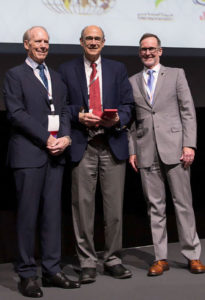
WFN medal awardee Dr Mark Hallett (contribution to neurological science), flanked by WFN President William Carroll and AAN President James Stevens.
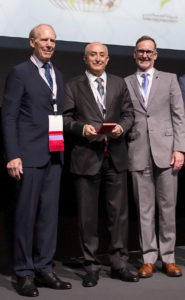
WFN medal awardee Dr Mustapha El Aloui Faris (contribution to international neurology), flanked by WFN President William Carroll and AAN President James Stevens.
Together with the other plenary lectures delivered each morning of the congress, these provided a veritable banquet of highly informative and interesting topics characteristically beyond the usual fare clinicians are exposed to. (See Figure 1.) They will undoubtedly stimulate young and older attendees to explore neuroscience and “edge” neurology with increased or renewed zeal. It is this blend of cutting-edge material presented alongside new research and clinical practice experience from the regular main topics and the teaching course material that is at the heart of a successful World Congress.
Altogether 264 invited speakers presented eight main topics, each of three to four 1.5 hour sessions with three speakers, 25 other topics of one to two 1.5 hour sessions, six regional sessions, 25 teaching courses each of three hours, three early morning teaching courses of one hour each, 1,438 posters (370 each day) and the extraordinary Tournament of the Minds. This year, 15 teams entered with each team comprising four members and subjected to carefully prepared questions to remove any language advantage or disadvantage.
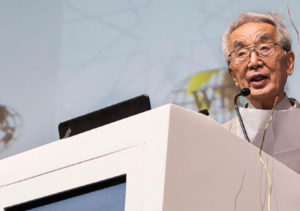
Dr Jun Kimura read the citation for Dr. Hallett on behalf of Dr Hiroshi Shibasaki.
The Tournament of the Minds proved a real competition and an immensely enjoyable educational event from its outset until the final as the last event on the Thursday. This too proved to be a hard-fought competition between the teams from Sri Lanka, Malaysia, India, and Hong Kong, all from the Asian and Oceanian Association of Neurology, until Hong Kong, coming from behind, emerged victorious. Congratulations to Drs. Wing Chi Fong, Ping Wing Ng, Annie Mew, and Andrew Chan and congratulations also to the Tournament of the Minds team of Richard Stark, Nick Davis, Faouzi Belhasen, and Serenella Servidei. (See photos on page 10.)
At the commencement of this column, I mentioned the “intangibles” which I believe are the hallmark of a truly successful congress. Together, these comprise a feeling that permeates all aspects of the congress for almost everyone through the 4.5 days. One sees people relaxed, enjoying the program, interacting with colleagues in an easy confident manner, seemingly relishing all aspects of the meeting. It stems from a good “connected” feeling that is no doubt the result of the quality of the scientific and teaching program, the lecturers and chairs, the congress app, the high quality of the AV and the AV service personnel, the ease of getting from one lecture room to the next, the exhibition, and the quality of the lunches and tea and coffee break refreshments.
Many other events occurred during the congress. The prestigious WFN medals were presented to Dr. Mustapha El Aloui Faris for service to international neurology and to Dr. Mark Hallett for contributions to neuroscience (see photos below), while the Ted Munsat prize for educational activities had a worthy recipient in Dr. Sarosh Katrak. There were numerous WFN committee meetings, including that of the Global Neurology Alliance, a relaxed meet and greet of young neurologists, and the selection of Montreal as the site for the 2023 WCN. The Montreal bid, led by Guy Rouleaux, defeated those of Mexico City (led by Miguel Osorna Guerra) and Rio de Janeiro (led by Fernando Cendes) for the right to host the XXVI WCN. The WFN is most grateful to all those who prepared their cases so well for this important decision.
For the first time, the WFN made a concerted effort to disseminate important messages emanating from the WCN through our inaugural Press Office, managed by Ashley Logan of Yakety Yak, and through the WFN social media outlets orchestrated by Kenes (Simona Milenkova and Milush Bahanov), the WFN e-communications committee (Walter Struhal and Tissa Wijeratne) and Yakety Yak (Ashley Logan). The WFN is most grateful to all those who contributed to this remarkable effort to showcase important elements of the WCN. (See Figure 2, which details this exceptional output, on page 2.)
At the closing ceremony, Prof. Suhail Al Akrun, president of the XXIV WCN, handed over the XXV WCN in Rome to Prof. Antonio Federico of the Italian Society of Neurology.
The XXIV World Congress of Neurology was an outstanding success, and the World Federation applauds all associated with the event for making it so. •
The plenaries at the World Congress of Neurology in Dubai.
The battle to beat Parkinson’s Disease
Patrik Brunden. See text of President’s report.
Precision Medicine in Neurology: Contributions by the Autozygome
Fowzan Al Kuraya described how populations enriched for autozygosity can contribute through unmasking the recessiveness of informative deleterious alleles.
Reading in the Brain: Mapping the Massive Impact of Literacy
Stanislas Dehaene elaborated on the investigation of several cognitive functional systems in the human brain but concentrated on the effect of the inferior right temporal lobe visual word form area and its relation to reading and to dyslexia.
Into the Grey Zone: Detecting Covert Conscious Awareness in Behaviourally Non-Responsive Individuals
Adrian Owen described research using fMRI, EEG, and functional near infra-red spectroscopy to detect covert conscious awareness in patients in vegetative or “comatose” states and then communicate with some of these through visual imagery thoughts.
Light, Circadian Rhythms and Sleep: Mechanisms to New Therapeutics on the Underlying Mechanisms
Russell Foster. See text of President’s report.
Treating Huntington’s Disease
Sarah Tabrizi described promising disease modifying therapy approaches that target proximal pathogenetic mechanisms ranging from DNA-targeting Zn-finger proteins, transcription activator-like effector nucleases and CRISPR/Cas9, to post-transcriptional huntingtin lowering methods by RNA interference, antisense oligonucleotides and small molecule splicing modulators together with a range of developments in biomarkers and drug delivery techniques.
Imaging Pain
Irene Tracey explained the recent advances in the understanding of chronic pain in the individual by investigating the perceptual and non-perceptual changes in pain perceptual pathways induced by sensitization, amplification or attenuation through functional and structural plasticity. Importantly, chronic pain is now such a burden it is recognized as a disease in its own right in ICD-11.
What is Genomics Teaching Us About Neurodegeneration
John Hardy explained that the gene loci involved in late onset neurodegenerative disease are associated with damage response processes and the observed pathology marks the type of failed damage response.
Multiple Sclerosis
Mar Tintore outlined the advances in understanding MS, its earlier diagnosis, more effective treatments and the influence of lifestyle and co-morbidities all leading to reduced disablement.
Brain Machine Interfaces: From Basic Sciences to Neurorehabiltation
Miguel Nicolelis described groundbreaking research leading to primate brains directly interacting with mechanical, computational and virtual devices without interference of body musculature or sensory organs. Such observations are pointing to the concept that the properties of neurally-controlled robotic limbs or tools can be assimilated by brain representations as if they were extensions of the subject’s body.
The Promise of the Brain Initiative for Those With Neuro/Mental/Substance Abuse Disorders
Walter Koroshetz. The changing emphasis of informed interventions based on previously invisible dynamic features of brain circuitry as opposed to the older static disease and treatment paradigms based on anatomy and pathology was highlighted in this visionary account of the impact of evolving technologies through the US Brain Research through Advancing Neurotechnologies and similarly aligned initiatives from around the world. •
Press releases during and following the XXIV World Congress of Neurology in Dubai
Oct. 28, 2019
Esteemed Panel of World’s Leading Stroke Experts from the World Stroke Organization Share Breakthrough Research on Relationship Between Stroke Risk and Vascular Dementia During Press Conference Broadcast via Facebook Live from XXIV World Congress of Neurology. Dubai, UAE
Potential audience 92.6 million
Oct 28, 2019
New Research on Migraine in the Workplace Unveiled During Press Conference to be Broadcast via Facebook Live from the World Congress Neurology, Dubai, Oct, 8 a.m. GST
Potential audience 80.58 million
Oct. 29, 2019
Effect of Climate Change on the Brain, Link to Alzheimer’s and Parkinson’s, to Be Key Focus of Discussion at XXIV World Congress of Neurology.
Potential audience 117.7 million
Oct. 24, 2019
World Federation of Neurology Reveals New Frontiers in Epilepsy Treatment for Children, Pregnant Women and New Links Between ADHD and Epilepsy at 24th Annual World Congress of Neurology, Dubai.
Potential audience 75.5 million
Oct. 23, 2019
World Federation of Neurology Joins Forces with the World Health Organization, Announcing “Groundbreaking” Reclassification of Stroke as a Disorder of the Brain; Launches Nine-Country Survey, Leading to Roadmap for Improved Neurological Care.
Potential audience 86.02 million
Post Congress releases during the week that commenced Nov. 11, 2019
The Prognosis for MS is Changing Due to Advancements in Treatment and Awareness, Yet Access to Care is Top of Mind for Global Neurologists
Pregnancy No Longer Believed to Modify Trajectory of MS, Experts Say
New Biomarkers Identified in Parkinson’s Disease Could Change Entire Trajectory of Parkinson’s Diagnosis and Treatment
Social media during the XXIV World Congress of Neurology in Dubai
Website: Over 311K page views from 75K people of whom 78% were new users. The top 5 countries were India, the USA, the UAE, Japan and Indonesia who went to pages on Registration Abstracts and Scientific program.
Targeted Google campaigns generated more than 17K clicks and almost 2.3M views, while social media campaigns generated over 10K clicks and 900K views. •
